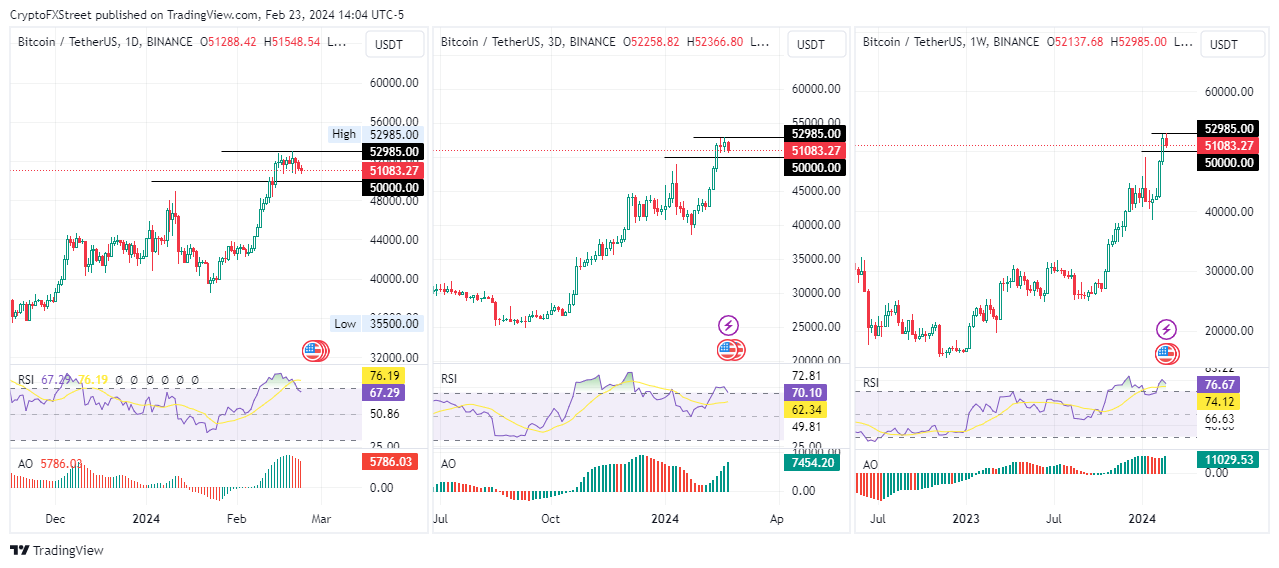Bitcoin price eyes $50,000 as Satoshi Nakamoto's earliest collaborator reveals their communication
- Bitcoin price has displayed a sustained downtrend over the past four days with lower highs and lower lows.
- BTC could revert to $50,000 amid low trading volumes and enhanced volatility characteristic of weekends.
- The bearish thesis will be invalidated if BTC breaks and closes above the $52,985 range high.
Bitcoin (BTC) price remains absent directional bias on higher time frames on Friday, but the outlook is different on the lower time frames. Meanwhile, the market is in awe after one of Satoshi Nakamoto’s earliest collaborators resurfaced.
Also Read: Top 3 Price Prediction Bitcoin, Ethereum, Ripple: Possible start of a trend reversal for BTC
Bitcoin, altcoins, stablecoins FAQs
What is Bitcoin?
Bitcoin is the largest cryptocurrency by market capitalization, a virtual currency designed to serve as money. This form of payment cannot be controlled by any one person, group, or entity, which eliminates the need for third-party participation during financial transactions.
What are altcoins?
Altcoins are any cryptocurrency apart from Bitcoin, but some also regard Ethereum as a non-altcoin because it is from these two cryptocurrencies that forking happens. If this is true, then Litecoin is the first altcoin, forked from the Bitcoin protocol and, therefore, an “improved” version of it.
What are stablecoins?
Stablecoins are cryptocurrencies designed to have a stable price, with their value backed by a reserve of the asset it represents. To achieve this, the value of any one stablecoin is pegged to a commodity or financial instrument, such as the US Dollar (USD), with its supply regulated by an algorithm or demand. The main goal of stablecoins is to provide an on/off-ramp for investors willing to trade and invest in cryptocurrencies. Stablecoins also allow investors to store value since cryptocurrencies, in general, are subject to volatility.
What is Bitcoin Dominance?
Bitcoin dominance is the ratio of Bitcoin's market capitalization to the total market capitalization of all cryptocurrencies combined. It provides a clear picture of Bitcoin’s interest among investors. A high BTC dominance typically happens before and during a bull run, in which investors resort to investing in relatively stable and high market capitalization cryptocurrency like Bitcoin. A drop in BTC dominance usually means that investors are moving their capital and/or profits to altcoins in a quest for higher returns, which usually triggers an explosion of altcoin rallies.
Bitcoin creator’s earliest collaborator resurfaces
In a recent post on X, one of Bitcoin creator Satoshi Nakamoto’s earliest collaborators, Martii 'Sirius' Malmi, shared emails among themselves. In the 120-page email history between them, Malmi revealed that Satoshi had envisioned the Bitcoin network having a maximum of 100,000 nodes. The latest data shows that the number of reachable nodes in the Bitcoin network typically range between 10,000 and 12,000.
The emails also reveal that Satoshi Nakamoto had anticipated more “newbies” and that BTC mining would be less energy intensive than the legacy banking system. Other highlights, as summarized by @pete_rizzo_, include:
- Satoshi foresaw at least one viable, non-monetary use for Bitcoin, backing the time-stamping use case.
- Satoshi was concerned about his legal risk in launching Bitcoin, noting he was "uncomfortable" with explicitly labeling it an investment.
- By July 2009, Satoshi was tired, saying he "needed a break" from Bitcoin.
- He believed in the easy adoption of Bitcoin, saying BTC was easy to obtain given that you could mine it on a computer.
- In June 2010, someone offered to donate $2,000 to Satoshi for his BTC work.
- The emails also reveal that Satoshi removed the language that Bitcoin was "anonymous" from http://Bitcoin.org.
Bitcoin price outlook as Satoshi’s emails to developer come to light
Bitcoin price is trading with a bearish tilt on the daily time frame, recording a series of lower highs and lower lows. On higher time frames, however, such as the three-day and the weekly timeframes, the outlook is rather indecisive.
With a bearish intermediate trend (daily time frame), the Relative Strength Index (RSI) shows Bitcoin price could drop further as momentum continues to decline. The histogram bars of the Awesome Oscillator (AO) have also turned red and are edging toward the midline.
Enhanced seller momentum could see Bitcoin price retest the $50,000 psychological level. An extended fall could send BTC to the $48,000 milestone, or in a dire case, extend a leg down to the $40,000 psychological level. Such a move would denote a 20% drop below current levels.

BTC/USDT 1-day chart
On the flipside, enhanced buying pressure could see Bitcoin price break above the range by shattering the $52,985 roadblock. This would clear the way for BTC market value to reach $55,000, or in a highly bullish case, reach the $60,000 psychological level.

